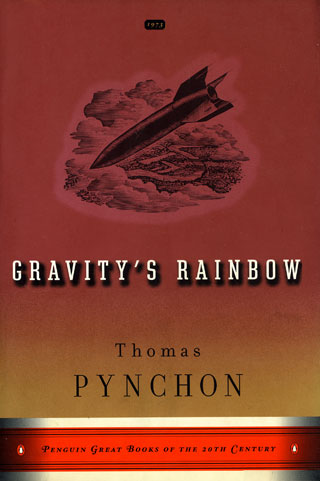
“Gravity’s Rainbow” by Thomas Pynchon
Books, ReviewsPynchon puts most other writers to shame with “Gravity’s Rainbow,” his surreal, mind-melting, madcap romp through post-war Europe.

Several months ago I asked for a friend’s opinion on a novel he’d just finished reading. “I liked it,” he said. “But it was a little long. And somewhat … self-indulgent.”
This brief review also serves as a fair summary of Thomas Pynchon’s mind-melting masterpiece Gravity’s Rainbow. Pynchon’s surrealistic romp unfolds in the waning days of World War II, as a fragile peace is descending over Europe. His subject is nothing less than the human soul – that modern concept of a willful and discrete “self”. It’s something we seem to take for granted, this identity we cling to and indulge, this person in the mirror, moving like a bright vector from past to present and on into the future.
“Who am I?” Pynchon’s novel seems to be asking.
It’s a concise question … small enough, right? But the answer leads to more, and bigger, questions. Am I the random remainder of my parental gene pool? Or the conditioned by-product of my surroundings? Am I free to change this thing called “me”? Does free will even exist? What is free? And perhaps the biggest question of all, the one that drives the parent of any four year-old mad with frustration: “Why?”
If that internal and discrete “self” is the quantum unit of Pynchon’s novel, the external and infinite cosmos is the flip side of that argument, the “context” or frame within which that self exists. Addressing one, Pynchon necessarily brushes up against the other. And so Pynchon expands his narrative scope, attempting to decode the narrative arc of human history itself, all of “human consciousness, that poor cripple, that deformed and doomed thing”.
Be warned: Gravity’s Rainbow provides remarkably little context for that little old “you” doing the reading. Pynchon’s story runs to almost eight hundred pages, and as the story blasts off it’s soon clear that the author has no intention of following a traditional “plot” or narrative structure. The book is held together by four hallucinogenic sections, like the pieces of the symbolic mandala appearing with increasing frequency throughout the text.
The Madcap “Plot”
In Part One, “Beyond the Zero”, Pynchon introduces a colorful cast of well-drawn characters. We meet American servicemen, German rocket scientists, British psychological warfare experts, Nazi industrialists, Russian mercenaries, African mystics, even deceased spirits from the “other side”, enlisted by mediums trained to communicate with the dead. I know from reading the excellent companion guide A Gravity’s Rainbow Companion (by Stephen Weisenburger) that Gravity’s Rainbow eventually presents us with more than 400 characters. But the casual reader will remember maybe a dozen of these, the key players in a psychological satire that begins as we meet one of the central protagonists, an American Lieutenant named Tyrone Slothrop.
Slothrop is stationed in London during the last months of World War II, and it seems that his promiscuous sex life is of critical importance to the Allied war effort. Slothrop has developed a habit of documenting his many sexual conquests, sticking multi-colored stars down upon a map of London after each tryst. Slothrop’s seemingly random collection of rainbow-colored stars correlates exactly with the pattern of German rocket strikes. Thus, wherever Slothrop orgasms (a metaphorical “little death”), a German V-2 rocket will soon deliver its own deadly payload.
The Pavlovian psychologist Edward Pointsman, running an Allied psychological warfare operation from a cryptic stronghold referred to as “The White Visitation”, is determined to uncover the mystery of Slothrop’s erotic visions. Pointsman enlists the Dutch refugee Katje Borgesius, an American named Roger Mexico, and Mexico’s lover Jessica. Employing his own extraordinary powers of Pavlovian conditioning, Pointsman trains an octopus named Grigori to attack Slothrop and throw him into the arms of Katje.
In Part Two, “Un Perm’ au Casino Hermann Goering”, Slothrop is sent to liberated Monaco, near southern France. At the fictional Hermann Goering Casino, Slothrop and Katje fall in love. Katje enlists a troupe of nameless characters to help steal Slothrop’s identity, and Slothrop dons the first of many disguises, posing as an English war correspondent. Slothrop begins his training in rocket science. We learn that Slothrop might have been subjected to psychological conditioning as a child by one Laszlo Jamf, much like the famous and tragic case of Little Albert. Slothrop discovers the existence of a German rocket with a unique and non-traditional serial number – SG-00000 – employing a newly-developed component called the Schwarzgerät (“black device”), which is composed of a fictional plastic named Imipolex G. Both Jamf and Imipolex G feature prominently in documents Slothrop discovers relating to his past. Slothrop flees Monaco and plunges into the Zone – the anarchic wastelands of post-war Europe – hoping to hunt down the Schwarzgerät and unlock the keys to his own absurd history.
Slothrop is pursued by shadowy characters throughout Part Three, “In The Zone.” Fumbling his way from one comic scenario to the next, Slothrop becomes embroiled in various drug-fueled, madcap adventures. In the mountains of Germany, Slothrop discovers that he has been conditioned to become sexually aroused in the presence of Imipolex G. Fleeing the dangerous American Major Duane Marvy, Slothrop escapes in a hot-air balloon to Berlin, where he dons the disguise of the comic-book hero “Rocketman” and embarks on a dangerous raid of Harry Truman’s temporary Potsdam residence to steal a stash of potent drugs. In Berlin (and later aboard the sea ferry The Anubis) Slothrop and the former porn star Margherita Erdmann engage in sado-masochistic sexual roleplay … until Slothrop discovers that the deranged woman believes herself to be a Jewish incarnation of evil, and that she has been sacrificing lost children found wandering in the post-war chaos of Germany.
Part Three is the longest and most digressive section of the novel. We are introduced to the stoic, dark-skinned African commander Enzian, leader of the Schwarzkommando or “black command” – a paramilitary force of African rocketeers intent on launching another rocket in the SG series, SG-00001. Enzian and Slothrop are both pursued by Enzian’s half-brother Tchitcherine, a pale and steely-eyed Russian mercenary intent on killing Enzian before he can launch the SG-00001. Meanwhile Pointsman has hired two American medical officers to capture and castrate Slothrop, believing this might negate Slothrop’s strange, predictive powers. But in a tragicomic case of mistaken identity, the brutal American Major Duane Marvy is castrated in Slothrop’s place, still dressed in the pig costume Slothrop had donned just days before. We are introduced to other major and minor characters, including the rocket engineer Franz Pökler and his doomed daughter Ilse. Pökler realizes that Ilse is being held hostage by the Germans in a nearby concentration camp, ensuring his cooperation with the Nazis in the production of the SG rocket. We discover that a Nazi Lieutenant Weissman, calling himself “Captain Blicero” (the “white death”), has sacrificed a young boy named Gottfried to the rocket, sending him up in the SG-00000 aimed for the North Pole, where Enzian and his people believe their ancestors return after death.
Slothrop’s dazed and confused wanderings are even more erratic in Part Four, “The Counterforce”. In a bow to traditional narrative structure, Pynchon thankfully brings closure to several key characters: “You will want cause and effect,” the author writes. “All right.” Pynchon then proceeds to bring the novel full circle: Jessica ends her adulterous affair with Roger Mexico; Pointsman is disgraced after the botched castration of Major Marvy; Enzian and his half-brother Tchitcherine are magically reconciled, avoiding the violent confrontation which has been looming between them; Slothrop apparently loses his mind, becoming a symbolic Fool who disappears into obscurity; the Americans bring the war to a cataclysmic end, dropping atomic bombs on Japan; and in a big finish, we flash back to the inside of the SG-00000 rocket, experiencing Gottfried’s final moments, as the boy is sacrificed in an absurd sexual rite by the mad Captain Blicero
Symbolism
Close your eyes and think of a symbol. Any symbol will do. Got it? Good.
Now open your eyes and flip through Gravity’s Rainbow. Odds are you’ll eventually stumble upon that image floating around in your head. Crosses? Got ‘em. Eggs and ellipses? Those too. Stars and pentacles? Arches and parabolas? Keys and locks and clocks? Check, check, and check. Teutonic mythological deities personified as rockets, bananas, giant penises, angels of death and destruction? Yep. How about a giant, glistening adenoid overtaking entire city blocks? Please turn to page fifteen.
The narrative presents a humorous and somewhat objective (if paranoid and often gloomy) case for the interconnectedness of all things. Circles and ellipses are used throughout the text to bolster this argument. Arches or parabolas signify entropy, or the illusory quality of political or religious belief systems. A parabola, after all, presents us with only a piece of the “whole” story, which would be the completed circle. Describing the rainbow, Pynchon writes:
… as we might imagine bounded below the line of the Earth it “rises from” and the Earth it “strikes” No But Then You Never Really Thought It Was Did You Of Course It Begins Infinitely Below The Earth And Goes On Infinitely Back Into The Earth it’s only the peak that we are allowed to see, the break up through the surface, out of the other silent world, violently.
Peaks and arches and phallic symbols (rockets, towers, bananas, trajectories) appear violently and often. The colors white, black, and red seem to signify a feminine sort of death, a masculine vehicle for regeneration, or some mystical communion with the afterlife. A doctoral student in psychology or literature could draft an interesting and relevant PhD dissertation on the use of the color purple in this Chinese box of a story.
But most importantly, Gravity’s Rainbow plays out in a circular pattern, mimicking the shape of the everpresent mandala appearing throughout the text, continually reinforcing and at the same time undermining its own narrative logic. Pynchon thinks like a mathematician, and at times I felt as if I was reading one giant, obsessive, mathematical proof. A symbol or character appears … only to be nullified or “zeroed out” by its opposite a few pages or chapters later.
So What Does Is All Mean?
So if Pynchon has set out to write a literary proof, what’s the theorem he’s solving for?
Control and power are a central preoccupation of the narrative. Early on, we learn from Pointsman’s work in Pavlovian conditioning that abnormal psychological pathology often results from a confusion of the “idea of the opposite”, and that abreaction or the reversing of a traumatic event can sometimes help to remove unwanted internal responses to external stimuli. As Pynchon’s story gets weirder and more complex, we are introduced to mathematical, theological, and other theories implying that many of our decisions are made beyond our own conscious control, as we drift along through life on a kind of auto-pilot.
The willful “self” we imagine controlling our actions can be plotted, Pynchon imagines, like a power series in math: a parabola describing our behavior, from birth to youth to adulthood and on into death. Much of the arc will be determined by our unconscious, the result of conditioned responses to events and stimuli outside of our control, with only a few willful decision points along the way. It is during the clarity offered by these “nodes” of free will that we experience and truly connect with the true nature of the universe. We seem to snap out of our zombie-like state and just “be” – for a second or two – outside the flow of time.
If the few truly willful decisions in life are the nodes along the way, what is happening the rest of the time? Pynchon postulates that all of human history is a result of repressed sexual desire: we are ashamed of what we view as “abnormal” desire, and so we bury these feelings deep in our subconscious. But this psychic energy must be released somehow. And so we create literature, technology, and science … we sublimate our shame and build monuments to it, disguised as art or politics or advanced technology. But this higher-order, rational thinking is really just a disguised version of our collective desire to be more like Slothrop, the priapic Fool wandering Europe in search of mindless sexual pleasures (Pynchon’s initial working title for this novel was “Mindless Pleasures”). And so our shame, disguised as science and technology, eventually enslaves and destroys us all – in the form of the Crusades, the machine gun, the concentration camp, World War II, the atom bomb.
But why are we taught to feel reflexive shame whenever the subject comes up? Why will the Structure allow every other kind of sexual behavior but that one? Because submission and dominance are resources it needs for its very survival. They cannot be wasted in private sex. In any kind of sex. It needs our submission so that it may remain in power. It needs our lusts after dominance so that it can co-opt us into its own power game. There is no joy in it, only power. I tell you, if S and M could be established universally, at the family level, the State would wither away.
You almost feel embarrassed just contemplating this strange idea. And that’s Pynchon’s point: why feel embarrassed about thinking, about an idea? Society is an endless cycle, Pynchon argues, heavily invested in creating the illusion of rationality, safety, and protection from violence. And we are heavily invested in buying into this illusion, because “reality”, as he describes it, is too violent for us to comprehend in its entirety:
Too violently pitched alive in constant flow ever to be seen by men directly … life so clangorous and mad, such a green corona about Earth’s body that some spoiler had to be brought in before it blew the Creation apart. So we, the crippled keepers, were sent out to multiply, to have dominion. God’s spoilers. Us. Counter-revolutionaries. It is our mission to promote death.
This disordered narrative is fueled by an almost insane attention to detail. Pynchon has placed every symbol and character here for a reason. He understands that his ideas are absurd – and so has written an absurd novel. He also understands that we seek order, rationality, patterns – and so has written a circular story sprinkled with symbols that nullify one another with scientific precision. The hilarious, disgusting, and squirm-inducing sado-masochistic sexcapades are here for a reason. Everything is “zeroed out” by its opposite for a reason. Pynchon has created a puzzle of sorts with this story, an attempt to understand the pathological psychological systems that result in wars and atrocities like World War II, genocide, or the atomic bomb.
In the end, this novel’s precise structure enables its surreal thesis to survive, and then thrive, in the reader’s own imagination.
But it’s not all doom and gloom … Pynchon truly cares for his characters. If the global military-theological-industrial complex is one side of the story, the individual humans suffering under its oppressive weight are the other side. “There is time,” Pynchon writes near the end of the novel, “if you need the comfort, to touch the person next to you.” Real human interaction can still offer comfort in the face of Pynchon’s paranoid vision – if only we take the time to reach out to our neighbors.
Should You Read “Gravity’s Rainbow”?
It’s a tough question to answer. As a writer, I’m glad I took the plunge. The sentences and phrases are often poetic. And the effort involved in creating the narrative’s ingenious structure is awe-inspiring. But I know for a fact that my wife’s book club, for example, would never submit to this novel’s solipsistic, often frustratingly digressive twists and turns. Pynchon’s masterpiece is good. It’s also a little long. Moreover, it’s truly “self-indulgent” – and all that this phrase implies.
And there’s no shame in that.























